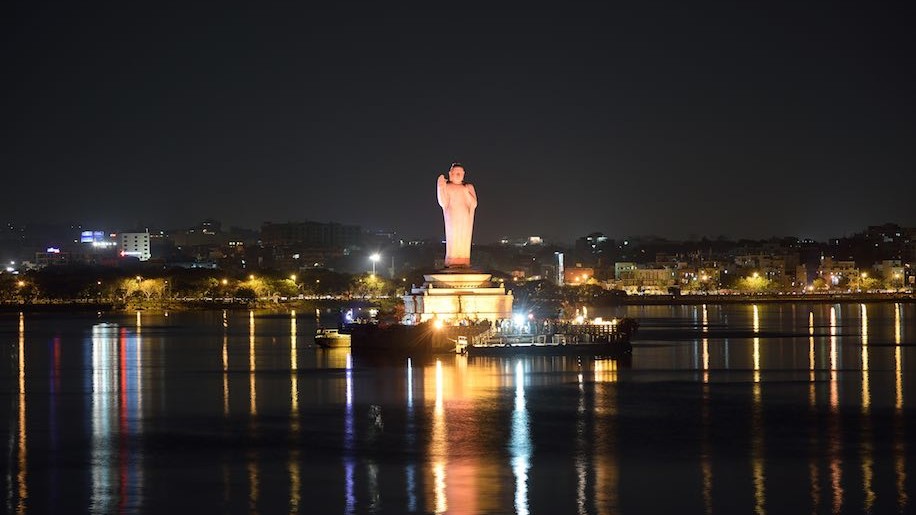
From the top of Golconda Fort you can see the outskirts of Hyderabad, more than ten kilometres away. White one- and two-storey houses chart the undulating hills in the foreground, while on the horizon are the modern office buildings of the Indian high-tech centre. The view has probably changed more in the past three decades than in the past three centuries, but there’s something timeless about the fort.
Originally a mud construction dating from the 12th century, it represented the heart of the former independent state of Golconda, home to the famous diamond mines, in the 15th and 16th centuries. After reaching its heyday, it faced rapid decline until 1590, when, after a water shortage, Sultan Muhammad Quli Qutb Shah moved the capital to the banks of the Musi River and created Hyderabad.
Left behind are thick walls, chambers, an armoury, palaces, temples and even a mortuary bath. After paying a small entrance fee (which seems to vary depending on who you ask), you walk through gardens to the giant Fateh Darwaza Victory Gate, where you may well see an attendant clapping together two pieces of wood.
The reason behind this becomes clear at the top of the 120-metre-high fort and the Durbar Hall, which sits at its peak, where the sound of the clapping is amplified by the dome above. In times gone by, this would have warned those higher up of an impending attack.
A tour takes you past cisterns and the glazed pipework used to convey water around the fort through barrel-vaulted rooms, where bats wheel in the darkness, then through large courtyards where open-air music and plays are often put on.
From Golconda, it’s easy to spot the onion-shaped domes of the Qutb Shahi tombs about a kilometre away. It’s an evocative place, with fragile minarets towering over grey granite tombs, which are a mixture of Persian, Pathan and Hindu forms, for an absent audience of worshippers and tourists. Some appear to be on the verge of disintegrating, the stucco ornamentation flaking away, and the admission fees are not likely to help.
It’s ironic that a region once famed for its wealth is so reticent to display its attractions. In a sense, the state of Andhra Pradesh, next to Telangana (Hyderabad is the capital of both), is where Bollywood bling began. The rulers had centuries of wealth and spent as extravagantly as you’d expect when they could dig diamonds from the ground – the most famous being the Kohinoor, now part of the British Crown Jewels.
Yet today, Hyderabad seems almost unknown to foreign holidaymakers, inexplicable when you consider its attractions. It has centuries of rich and documented history, astonishing palaces, forts, formal gardens and ancient tombs, all easily accessible from the city. The climate is kind, with temperate weather most of the year, and the cuisine a marvellous mix of spicy vegetarian dishes from the south, along with traditional kebabs left by the Mughal rulers.
Unlike much of India, Hyderabad has excellent infrastructure, with a good road system, a modern airport and a selection of five-star hotels at bargain prices – the Westin Mindspace, the Trident and the Novotel Hyderabad Convention Centre, to name a few.
Still, it’s the monuments that are likely to be the focus. If you go to Chowmahalla Palace, you’ll see how the post-Mughal Nizam family spent its wealth. Extending from the famous, hectic Laad Bazaar to the north – site of the wonderful 1591 Charminar monument – to Aspan Chowk Road to the south, the palace originally covered 18 hectares (about four remain). A replica of the Shah’s Palace in Tehran, it dates from 1750, with Nizam Afzar-ud-Dawla Bahadur completing the building work in 1869.
The fountains and gardens are a great place to while away the hours, and you can enjoy exhibits from the past couple of centuries, or the 1912 Rolls-Royce Silver Ghost or lesser-known Napier cars from the same period, each lovingly restored.
After a spot of shopping at Laad Bazaar and a visit to the Mecca Masjid, end your weekend at the fairy-tale Falaknuma Palace, built on a hill above the city in the late 19th century by then-prime minister Nawab Vikar-ul-Umra. He wanted to show what the region was capable of, and the fine marble, jade and precious stones, as well as the latest technology – some of the first fridges and telephones in the country – did just that. Unfortunately, he ran out of money, was rescued by the Nizam of the day, and the palace was then used to receive important visitors, such as King George V in 1911.
Now renovated by Taj Hotels, it allows you, for a short time at least, to live like these opulent rulers, without the worry of the running costs. A sufi band playing in the courtyard for sundown cocktails, and dinner at Adaa, where you can feast on Hyderabadi cuisine with the city spread out below – it’s the perfect end to a few days of luxury.










